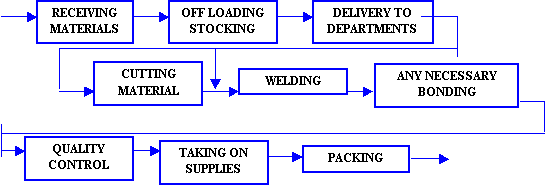1
MANUFACTURING PROCESS
1.3 Composite
materials
1.3.1 The manufacturing process
1.3.2 Materials
1.3.3 Cutting
1.3.4 Joining
1.3.5 Bonding
1.3.6 Quality
control
1 MANUFACTURING
PROCESS
1.3
Composite materials
1.3.1
The manufacturing process
The construction of
rafts and boats in composite materials has a less complex manufacturing
cycle than those described above. This is due to the smaller
dimensions of the vessels in comparison with steel ships, and
the smaller number of operations required to produce the vessel.
The main operations in producing composite material boats, commonly
referred to as inflatable boats, are cutting, welding, bonding
and cleaning.
Figure 3 shows the manufacturing
cycle.

Figure
3 - Manufacturing cycle in shipyards building vessels in composite
materials
1.3.2
Materials
Inflatable vessels are
built using a composite material made up of cloth covered in
resin. The strength and thickness of the sheets is increased
by using more layers, so that the end-material used is multi-layer.
The cloth is made from
fibres which have sufficient resistance and flexibility; polyester
and polyamide are among the most commonly used artificial fibres.
The resin must be capable of producing flexible sheets, which
are completely impermeable and easily welded together. Polyvinyl
(PVC) and polyurethane are the most commonly used types of polymer.
On arrival materials
are off-loaded and stored in a warehouse. The materials are
chiefly PVC and polyurethane, equipment and fitting-out material
(handles, hooks etc).
The material is then
divided between the departments in accordance with the manufacturing
cycle.
1.3.3
Cutting
The material is firstly
delivered to the cutting department. The main operations here
are the same as in an industrial tailors: models are drawn onto
the material, showing fixing points for later joining operations.
The material is then cut.
The sheet is taken to
a table, where it is cut by hand or machine following a model.
Simple scissors or similar tools may be used by the skilled
operative. The process is not automated as the model of the
pieces of material often varies according to the product to
be made.
1.3.4
Joining
After cutting the various
pieces are delivered to the appropriate joining department.
Each department specialises in a particular joining technique:
·
High frequency joining, which exploits the dielectric
properties of the material;
·
Hot air or wedge joining which causes controlled fusion
of the material.
In the high frequency
joining department small standardised pieces with particular
shapes are joined, such as handles, hooks and blocks. To make
the joins, moulds made out of good conductors such as brass
are required, so that they can adapt to variations in the size
or shape of the piece. In practice the moulds have the same
shape and size as the joins.
The operation consists
of several simple phases: first the two different pieces are
put together on the mould and pressing begins while charging
the two pieces oppositely causes the molecules in the two pieces
to move in such a way that they effectively become one piece.
Small sized pieces in
difficult shapes are often fixed to a small cloth backing which
is in turn joined to the vessel. This technique allows any material
of small dimensions to be fixed to the boat.
Fully-equipped individual
parts can be produced in the high frequency joining department.
Non-standard sections
are made in the hot joining department, using the hot air technique
and straight-line joining with hot wedges. These lead to the
assembly of ready-equipped pieces produced by the high frequency
joining department. Joining departments normally work in series,
but some operations are carried out in parallel.
1.3.5
Bonding
Certain types of vessel,
which have structures in fibreglass and material, such as keeled
hulls or driving consoles, must be bonded together. The fibreglass
piece, built as described above for material pieces, is bonded
and the quality of the operation immediately tested.
Surfaces to be bonded
are prepared by cleaning with solvents.
1.3.6
Quality control
The product is then
checked for quality. These checks are non-destructive:
·
That the vessel is fully equipped
·
Pressure holding
·
Equipment installation
The final
stage of the manufacturing cycle is the loading of equipment
and packing. These final operations are strictly dependent on
the type of product.